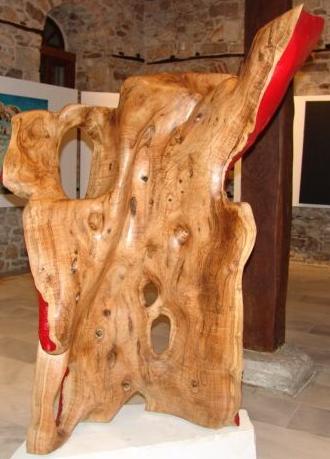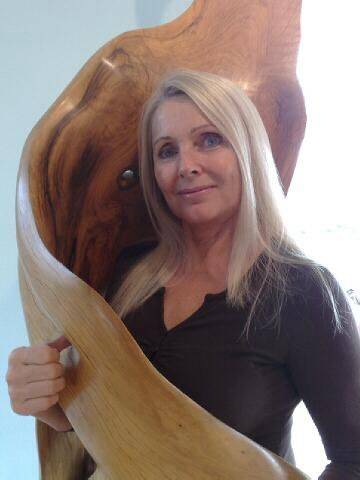the olive wood wonders of

RENA MEREN
by
LYDIA SCHRUFER
___________
 As
I read through some of my previous artists’ interviews,
I realized that sculpture had been inadvertently short shrifted,
which makes me happy to remedy that shortcoming with an introduction
to an Austrian sculptress whom I met on a recent trip to Vienna.
As
I read through some of my previous artists’ interviews,
I realized that sculpture had been inadvertently short shrifted,
which makes me happy to remedy that shortcoming with an introduction
to an Austrian sculptress whom I met on a recent trip to Vienna.
Rena
Meren is a multi-disciplinary artist. She has a studio in Vienna
which she uses primarily for painting. But for three to four
months a year she lives and works in the verdant Greek island
of Thassos, the most northerly island in the Aegean; it is where
she creates her beautiful olive wood sculptures.
For
the past 15 years, Rena has been leading seminars in painting,
sculpture and Qi Gong -- a five thousand year old Chinese discipline
-- on her adopted Greek island. She discovered the island during
a vacation and has spent summers there since 1985.  Our
interview was conducted in German which I’ve translated.
We spoke about her methods, materials, her philosophy and how
she came to work with the beautiful olive wood.
Our
interview was conducted in German which I’ve translated.
We spoke about her methods, materials, her philosophy and how
she came to work with the beautiful olive wood.
“On
August 15, 1985, and for four days, fire ravaged the island
of Thassos. When the smoke cleared the devastation was heartbreaking,
especially for the now charred old olive trees.”
Rena
loves wood and began to explore its possibilities found at the
core or heart of those burnt trunks and roots. Under many centimeters
of soot, she painstakingly and methodically scrapes and gouges
away the damage to expose the undamaged wood where the structure
becomes her inspiration for her sculptures. Sometimes, after
a long days work, she will have managed to uncover only a small
area of sinuous beauty. She creates with great care and reverence
for the forms that have taken centuries to grow ; each cut,
scrape, drilling and other interventions are carried out with
great  concentration
and consideration. Rena says that she doesn’t alter the
structures, she merely sets them free. It is through her special
relationship with the antiquity of the wood she is able to unlock
the forms and reveal the aesthetics that have been growing inside
the trees for hundreds of years. She likes the idea that she
is playing a small part in the preservation of our environmentally
challenged planet, and regards manual labour as an antidote
to our technology driven hectic times.
concentration
and consideration. Rena says that she doesn’t alter the
structures, she merely sets them free. It is through her special
relationship with the antiquity of the wood she is able to unlock
the forms and reveal the aesthetics that have been growing inside
the trees for hundreds of years. She likes the idea that she
is playing a small part in the preservation of our environmentally
challenged planet, and regards manual labour as an antidote
to our technology driven hectic times.
Although
Rena works in many mediums, her olivewood sculpture is, for
her, a form of meditation, joy and self-discovery. She creates
very large sculptures that may take many months to complete
so during that time she also works on smaller pieces and draws
or paints from nature. The smaller works and the paintings and
drawings from nature are a diversion from the labour intensive,
physical demands required by carving the very hard, dense grained
olivewood. Some sculptures are then cast, from the original
wood, in bronze foundries.

Her
sculpture
forms remind me of the sweeping curves of Henry Moore, and Rena
admits her affinity for his sculptures, but she has also been
influenced, since childhood, by her friend and  mentor,
the famous sculptor, Josef Pillhofer, whose works can be found
world wide. And although there may be similarities to other
artists, Rena’s work is signature unique because each
old olive tree contains its own particular story: like Thassosian
leaves or Alpine snowflakes, no two are alike.
mentor,
the famous sculptor, Josef Pillhofer, whose works can be found
world wide. And although there may be similarities to other
artists, Rena’s work is signature unique because each
old olive tree contains its own particular story: like Thassosian
leaves or Alpine snowflakes, no two are alike.
Rena
is tireless and her creativity is not limited to the visual
arts. She is the author and illustrator of five books that explore
a variety of subjects including the Greek landscape that inspires
so much of her work. She occasionally reads her stories at impromptu
public readings; it’s only a matter of time before publishers
discover her. Readers can learn more about Rena Meren on her
website: www.artandsun.at